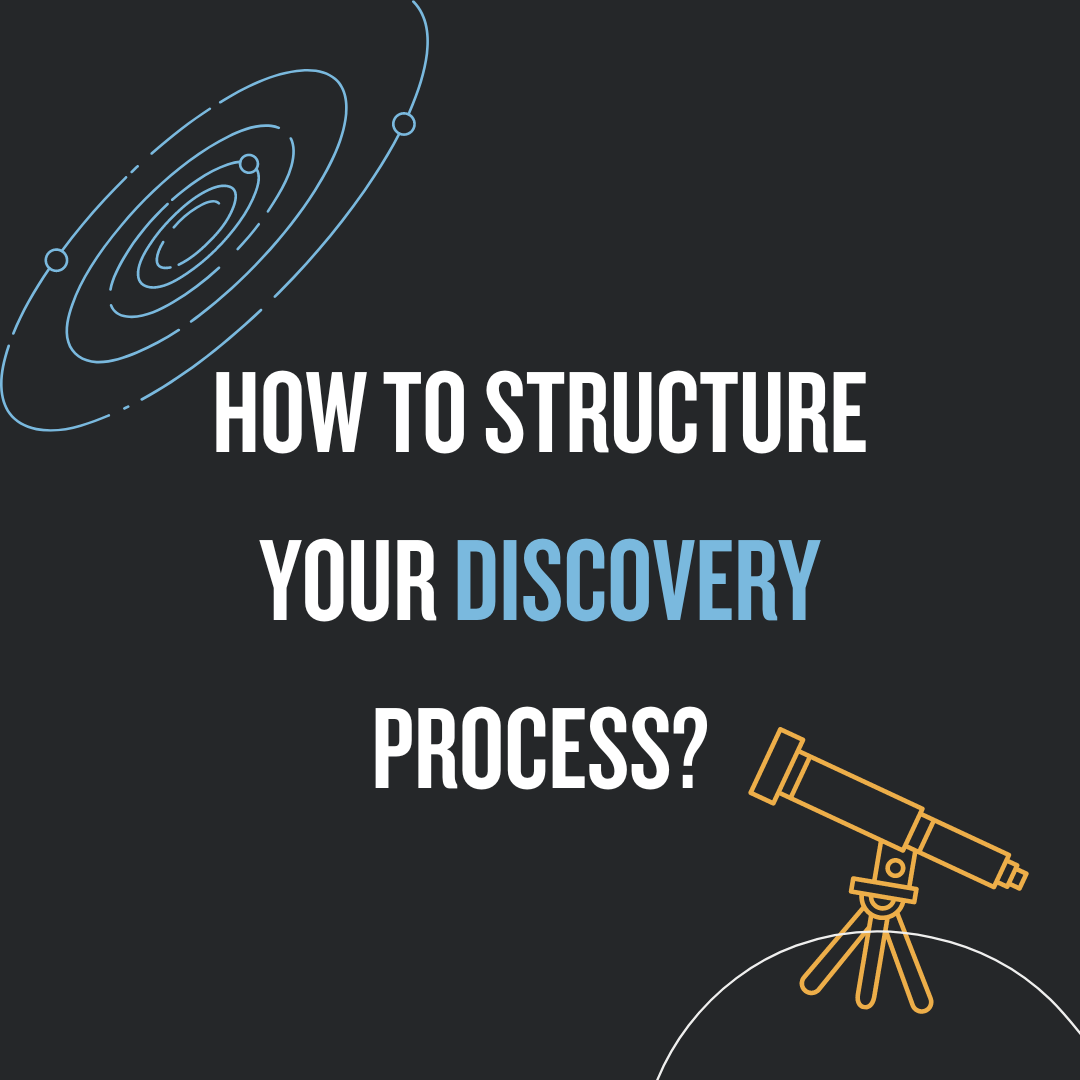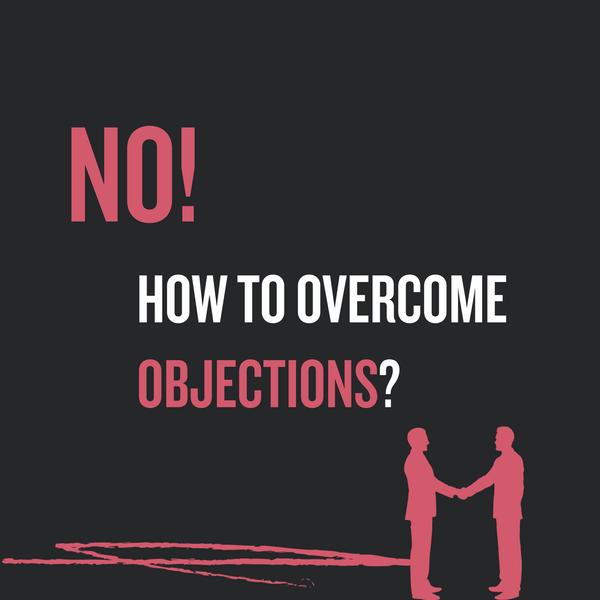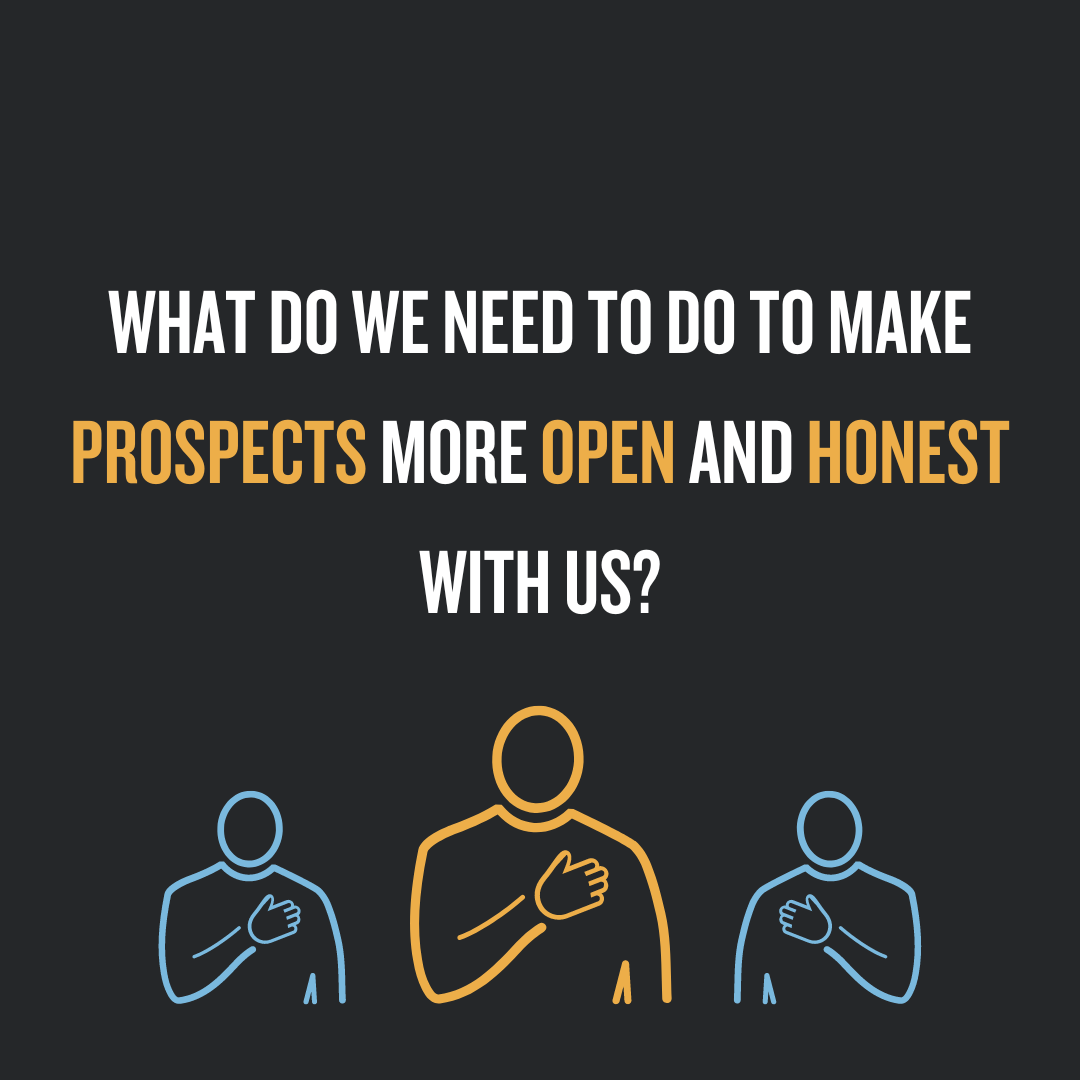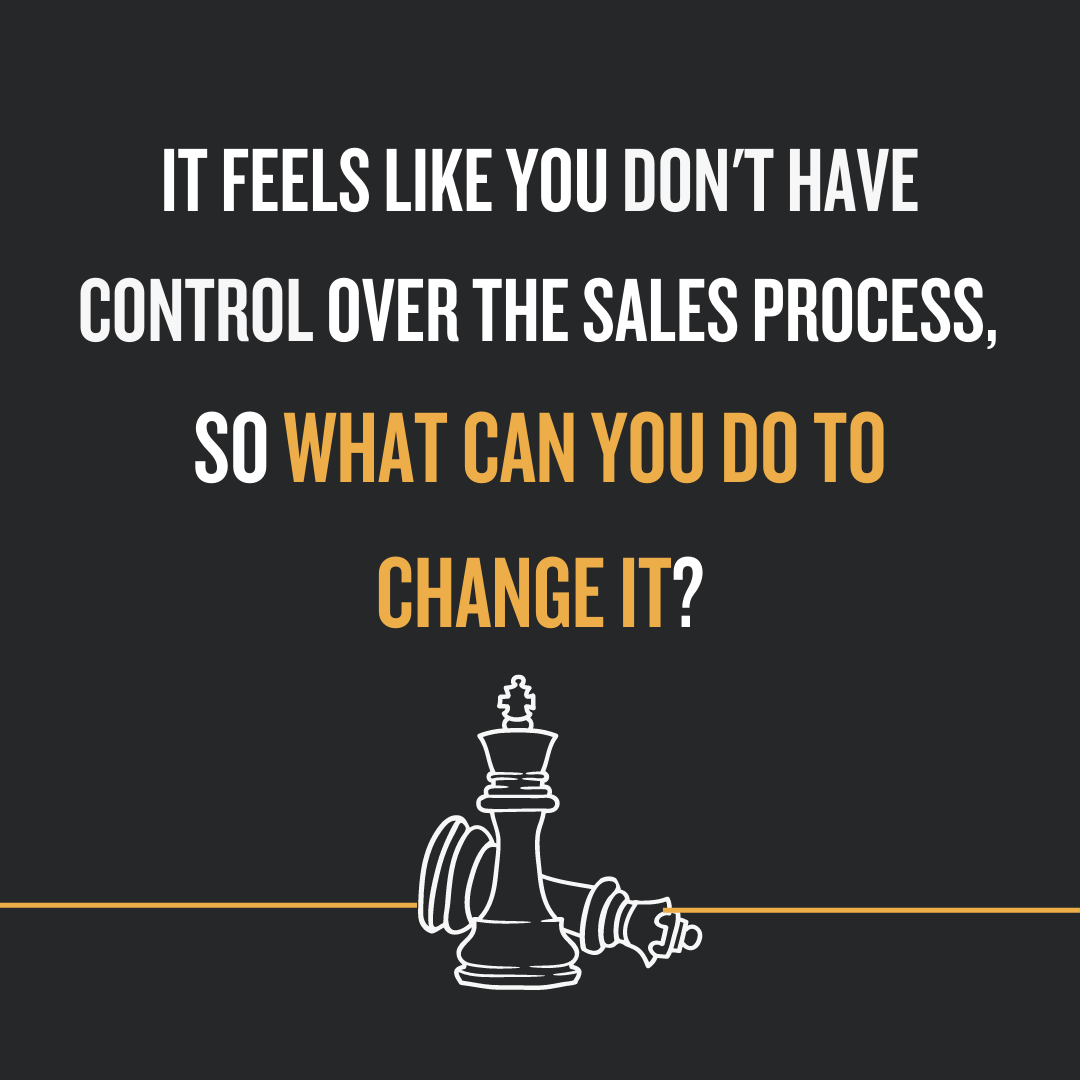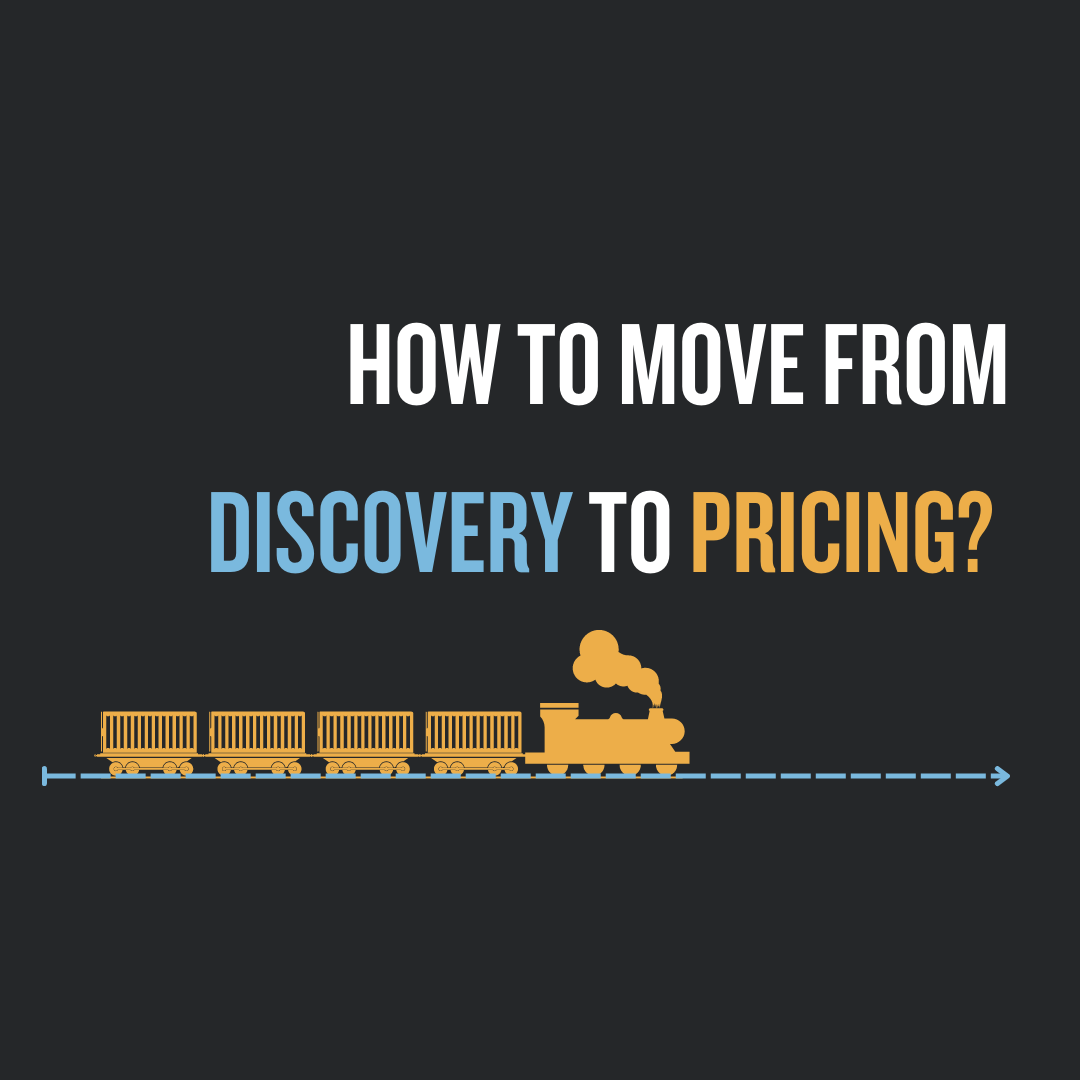The main goal of your call is to always learn more about the prospect and the way you can help them, right?
But the discovery process is tricky and it’s tricky because it’s intuitive.
You see, everyone is different and requires a different approach to them. As well as that, you need to be able to read the room, to know when to push and when to stop. All of this creates an extremely difficult environment for you to sell and sometimes even the easiest demo feels like a field full of traps.
But here is the good news for you: even the most challenging process can be simplified with the right points in mind.
So, in this long (but absolutely worth it) article I’ll guide you through the main points to consider, so your discovery process will feel more structured and ready for any unexpected turn.
Worksheets are available to download later below.
So, let’s not waste our time and start from the beginning:
Always adapt your style
Now let's talk about adapting your style to match the prospect’s title and role.
There are two types of people you might want to sell your product to:
- Power-user and champion
- Decision maker and C-Suite
The first type is called the power user. These people will be using your product every day and they might become the champions who get other people on board with using your product.
The second type is the executive or C-suite. These are the people who make the decisions about whether or not to buy your product.
So, you can already see how those two types of prospects are different. One will use your product and the other will actually buy it. And your main task here is to adapt your style: questions, answers, and key points, so the other party will get information tailored to their area of interest.
For example, if you’re talking to a power user, it is a good thing to go into detail about how your product or service can provide value and how your solution can help them meet their needs. You even have the freedom to go deeper into the product and how it helps the prospect every day. Because your power user will be interested in that and will have the ability to understand the true value of your solution.
And now, imagine you're just talking to the person in charge of making economic decisions. They don't care about the details of how the system works - they want to know how it will help them and what benefits they’ll receive. Here you need to show them that you are addressing their pain and needs and that you are giving them a good return on investment.

So, basically, your prospect has different interests:
Power-user wants to learn about the system and the decision-maker needs to focus on ROI.

And now, you may ask something like:
“Okay, well what happens when I have the economic decision-maker on the call, as well as the power user?”
This situation happens quite often, so there is no need to stress about it. Here your task is to manage expectations with your key contacts on the prospect side (your champions).
Because you need to make sure that the people who will be using the product every day understand what they're getting and really want it. At the same time, you need to make sure that you are addressing the concerns and needs of the executives on the call. To tie all of the interests together, you may start your conversation with something like:
“I want to make sure that we are exploring how we can navigate through this call together.”
And this is your cue to invite your champion to help make sure that both power users and the executives receive the information each of them needs.
Another thing to consider here is the way your champion will help you. Champions are your greatest supporters but sometimes they tend to overtake the call.
Here I advise remembering that you are the one in charge of the conversation. You are the one who will make sure this deal goes through. So, relying on your champion is good but trusting your instincts (that come from your past experience with similar deals) is even better.
Before I move to the next point, let's cover one last thing: what can you do if you are talking to a key decision-maker and a power user starts to take you off course?
One way to keep people on track is to use an agenda. This will help you remind them of what is happening and why they are there. You can do this in a way that is respectful and delicate.
But number two, make sure you are in control of the meeting and don't let the champion take over. You should be the one asking questions and guiding the conversation. If they have more questions, suggest having a separate call so you can cover everything on the agenda.

Talk less than 50% of the time
At some point, we all wonder: did I talk too much or too little? So here is the main question of this part:
What is the right amount of time for a sales representative to talk to a prospect during the discovery process?
And the funniest thing here is that even this question is wrong to ask. Whenever you are on a call with prospects it's always about them and how much they talk. So the right question to ask yourself is how much should your prospect talk during the call.
Now, we're looking for a real human connection with our clients. The discovery call is all about us getting to know them on a deeper level and truly comprehending what their requirements are, how they make decisions, and the influence of their pain. We'll never get there if we don't give them the floor; otherwise, we'd never really know what their current circumstances are.
So, here I advise making sure that you talk for 50% of the time or less when you have a discovery call. This way, you will be able to learn more about the other person and they will learn more about you. We will give you some tips on how to do this in a future video.

Understand the reasoning behind the question
Understanding your conversationalist is a key factor for productive dialog.
Sometimes it is easy to figure out what the other person is talking about, but other times it can be hard. From your experience, you may remember strange questions asked by your prospect that you didn’t understand at first. And here it’s important to be curious and ask yourself:
”Why did they ask this? Where is it coming from?”
If a prospect asks you a question that you're not sure about, it's okay to ask them what they were thinking when they made the question. Usually, people ask questions because they want to find out more information.
This might be because they are curious, or they don’t understand something, or their boss might have asked them to find out more information. Sometimes prospects can ask questions for other reasons, for example, if there is an important event coming up.
And the mistake a lot of sales reps make is answering "Yes" or "Of course" when they really don't know if they can do something or don’t even understand the question. So, here I advise you to show curiosity and say:
"I would like to understand more before answering. What is it you need?"
This question from your side has a positive bonus as well: it would show that you want to help out your prospect and will add to the trust-building process.
And now imagine the prospect answering:
“Oh, I've been tasked with absolutely making sure that we get a new solution provider by the end of the quarter.”
So, they may be searching for other organizations now. But if you know that nugget, you'll know they won't stay with a current solution for long. And it really enables you to ask an excellent follow-up question: "Wonderful, what's causing that?" or “Love to hear why that occurred?” or “Where did this idea come from?” There are a lot of interesting questions you might ask about it.
It can be tough to stay focused on what is important when you are selling something. But that is what good salespeople do. They focus on what the customer wants and how they can help them.

Uncover the pain of the status quo
When you are making sales calls, it is important to remember that discovery is a key part of the process. Many sales reps make the mistake of talking about their products without first figuring out what their prospects need. This is called 'feature dumping' or 'showing up and throwing up. It's when you just talk about all your features and benefits without considering what your prospect wants. So make sure you're not guilty of doing that.
It is very important to understand not just how much pain your customers have, but also the consequences of not doing anything. This includes understanding how many deals you lose to competitors and how many deals you lose because people are happy with their current solution. Often, this number depends on the business. For example, some businesses lose 20%, 30%, 40%, or 50% of deals to their current solution.
Many times, this means that the sales professional did not do a good job of understanding what is wrong with the prospect's current situation. They need to understand what isn't working and how it is affecting the business. They also need to put a number on it to show how much it is costing them.
We want to create a good understanding with our customers of the current pain and the status quo. Some professionals refer to it as giving the prospect a headache first and then handing them Tylenol later. Sounds weird but that's how this process really is.
You are telling the prospect all the problems they are having, and how your solution can help. You are also saying how much better things will be for them if they choose your solution. You are showing them that it is worth the money to buy your solution.
Many sales reps talk about the future, but they don't talk about the present. They can't explain how things will be different if their customer or prospect decides to move forward. If a sales rep doesn't understand the difference between the current state and the future state, they will lose most of the time.

You need to be better than your competitors. Make sure you understand the pain your prospect is feeling and also understand the consequences of not taking action. Get your prospect to walk through that discussion with you so they can feel the emotion of it.
People make decisions based on their emotions and logic. When we are emotional, it is hard to think logically. We need to understand people's current situation and how our product or service can help improve their life. We should explain the future state and how our product or service can help them get there. That's the simple truth behind the deal.

Ask them what they're thinking
When you ask your prospect how they feel about the other solutions they are considering, or their current solution, you should be honest. Don’t be afraid to tell them what you think. You might guess that this will make them think about your competitor more, but in reality, it is usually the most effective way to move forward.
This will help you figure out why the prospect might be thinking about those other solutions, and how you can convince them that YOUR solution is better. You can even ask them questions about their conversations with other companies. It's crucial to compare your product to competitor's. If someone liked a feature of your competitor's product, they are likely to enjoy yours too.
I know, we don't want to focus too much on our competition, but we do want to understand what our potential customers are thinking. We should ask them questions about the solutions they saw, including ours, and how it compares to what they already have.
And if you want to read more about how to talk about your competitors, feel free to check out my article here.

Focus on THEIR end goal
There is a very popular saying in the sales world:
As long as the sales rep's talking - they're selling, as long as the prospect's talking - they're buying.
Remember that when you are selling, it is important to focus on your prospect. You need to think about what they want and what they are looking for. Don't think about yourself. That way, you can better understand what they need and how you can help them.
If you go into a discovery call with that frame of mind, you'll be more successful. Most sales reps just talk about themselves without realizing it.
Here is the thing, those who really seek to understand what is important to their prospect - the pain, the impact of the pain, and how much it is hurting them - are more successful. And that's as easy as that.

How long should the discovery take?
People often ask what the ideal length for a discovery call is.
This really depends on whether it is a transactional sale or an enterprise sale. In most cases, it doesn't make sense for our customers who are selling into emerging markets to have a long phone call. The average contract value or order size is usually around $5,000-$11,000. It's also not cost-effective for buyers to have a lot of follow-up calls.
When we are looking at an enterprise motion sale, and the ACV is high six figures or more, it is important to do a lot of discovery before moving forward. But I can share with you a few best practices on how much discovery should be done in these cases.
There are a few things that sales representatives often do wrong. One is that they think it's inappropriate to ask their prospects a lot of questions. But in reality, questions will help to make sure you understand prospects' needs so you can provide the best solution possible. So asking a lot of questions is actually what's best for the prospect.
There are a few things that I recommend when you're doing discovery.
First, don't assume that the prospect doesn't have the patience for your questions. Often, sales reps will ask questions based on their own thoughts and not what the prospect wants to know. So that's number one.
Second, it's important to remember that when you have a discovery call with someone, you need to ask them questions. This is in their best interest because it will help you understand their pain and what they actually need. Then you'll be able to provide them with a solution that is better tailored to their needs.
Sales reps seem to think that people only do discovery because they want something for themselves. They think the prospect will feel this way too. But you can overcome this by framing discovery in a way that shows the prospect you are doing it in their best interest. This is because you want to understand their needs better. You can create a custom solution for potential buyers that is specific to their needs and won't waste their time.
Good sales reps always explain why they are conducting a discovery process with a prospect, and they also demonstrate the value of doing so. This gives the prospect a roadmap of where the conversation is going.
People might not like it if you start asking them a lot of questions without any explanation. But if you explain why you're asking the questions, they will be more understanding.
Sales reps often say that they think it's because the prospect doesn't have tolerance for a long discovery, or that it would feel unnatural. And so what ends up happening is they deliver a boilerplate standard demo that actually isn't catered to the prospect's needs. That's not in the prospect's best interest at all.

It is really important for sales professionals to understand the needs of their customers. A lot of sales reps try to avoid asking questions during demos, but that can be a mistake. Asking questions during a demo is a good way to have a two-way discussion with the customer.
There are five things you can show your prospect. If you do a good job of understanding their needs, and you figure out that they are interested in two of those things, then you should spend most of your time demoing those two things.
Keep this in mind when planning your sales strategy. It is in your prospect's best interest and yours to figure out their needs before you start selling to them. You can do this by asking questions during the discovery process. This will help you focus on their needs and give them what they want.

Checking in during discovery
How can you tell when you are asking too many questions?
This is a question for the ages but gladly I have an answer for you.
The answer is that you need to use your intuition. If you feel like you are asking too many questions or if it is making the other person uncomfortable, then it is probably best to stop. You should also rely on your intuition when deciding how to act around people.
Usually, you can tell when someone is getting impatient. If the prospect is getting a little short, or if they are getting annoyed, you should quickly check in with them:
“I appreciate your patience, we are almost done.”
This will help us tailor our discussion to the prospect’s needs.
It's a little like, you know if you're on hold with your telecom company and they say, "Hey, you're the fifth caller and it will be another 10 minutes until your call is answered." You feel a little less anxious because you have an idea of how long you will have to wait. You want to respect the prospect's time by giving them an idea of how long they will have to wait.

Find out key voices
Now, we want to know the prospect's timeline and who else will be involved in making the decision. We also want to know who the final decision maker is and how they will make the decision. If there are people who are influential, they may not have the final say in what happens.
Here is the thing, in order to make a successful enterprise motion, you need more than six or seven people who have been involved in the process from beginning to end. If someone leaves the company, another person in the group will hopefully become an advocate for your product. Having more stakeholders involved in the process just improves your chances of closing the deal.
After you finish your demo, ask who else needs to see it. Make sure you understand who all the different stakeholders are and what their roles are. Find out who the key voices are and get their input.

There are two types of people you can talk to about your business: users and leaders. But you need to get permission from your champion before talking to them. If it is a bigger deal, it is worth spending time on. If it is a smaller deal, you don't want to waste time if it isn't going to be fruitful.

Understand the true impact of the pain
There is one thing that all sales reps can agree on: we don't want the prospect to feel like they're being interrogated.
Making your prospect feel more at ease can be tricky. But one way to do this is to make it a bit of a give-and-take. So don't bombard them with questions, instead, add in the odd tidbit or a bit of information from time to time. This will help make the conversation more natural.
The other thing is if you have asked a question and the prospect gives you a lot of information back, it is helpful to keep the conversation going by responding in a similar way.
Sometimes people talk for a minute or three. And during this time prospects might give you some good information. So, it’s important to understand that information and to show that you understand it by acknowledging it, empathizing with what they said, and then unpacking it.
There are three key points that your prospect mentioned in their one to two-minute summary of their needs. You want to summarize and say "So, I think if I'm hearing you correctly, there are three needs. One, two, three. If it's okay with you, I'd like to unpack that one by one."
You're doing a mini agenda here. This is when you repeat back to the person what they said, to make sure you understand them correctly. This can be impactful because it sometimes triggers something else the person said.
Prospects might tell you things that are different from what you expected. When this happens, it is a good idea to check your facts and get more information. Then, summarize what the person told you and explain it in detail.
If someone is talking about one of their problems, it might be that they are feeling overwhelmed because they have a lot to do. You can start by asking them questions about what they said. For example, you could ask them how they feel when they have so much to do. Once you've unpacked that, and understood the impact of each of these pain points or needs, then, after you've quantified it then you go to the next one.
So the next point here is understanding the true impact of the pain that the prospect is feeling. And here you need to try and get to the impact of the pain. Some people feel very busy at their job and that they are bottlenecking things because their current solution isn't helping. What you want to understand is how many hours per week the prospect feels like the current solution doesn't help with the one task they're taking on.
If you multiply the number of employees who have this pain by the number of hours they work in a day, then you can see how much this problem is costing the company.
You want to measure how much the prospect cares so you can understand their feelings better. Later, when you try to close the deal, you might ask them how they're feeling. If the prospect is not interested or doesn't seem to care as much as you thought they would, you can remind them of the pain that you both understood.
And you can also quantify the pain to show them how serious it is.
If the prospect will say they don't care about the future problem, you can say that it’s ALREADY a problem for them. And you are sure about that because you went down the funnel and understood why their job was getting bottlenecked. And now you also understand how it affects their time and what the impact is in terms of hours and dollars per year.
When the prospect will say to you that they don't want to buy your product, they may say that they think they're "just good" with their current solution. But you can then ask them if they're still having problems with their current solution because you mentioned that they were in a situation where they felt like they were bottlenecking a bunch of things.

At this point don't be shy and just ask the prospect something like:
"You're not the only one with this problem. Five other people are in the same situation. When we talked about it, we found that this was causing a lot of money to be lost. So I have to ask, what is your plan?".
That is an effective way to respectfully challenge the customer.
Sales reps often don't ask challenging questions that will make the prospect think about things from a different perspective.
When you are conducting a discovery call and the prospect spends a few minutes giving you some interesting feedback on their challenges, here's what I recommend you do.
This is why the best salespeople are usually the ones who do the best discovery. They uncover the pain that a customer is feeling and they quantify it so they understand the current state very well. Then, when they go to actually close the deal, they can handle objections by explaining why their product is better than a competitor's.
Here, once again, I advise using customer stories to help the prospect to understand the impact of choosing your solution over the current solution. This helps you quantify the difference in terms of what is currently causing pain, and what their future state could be.
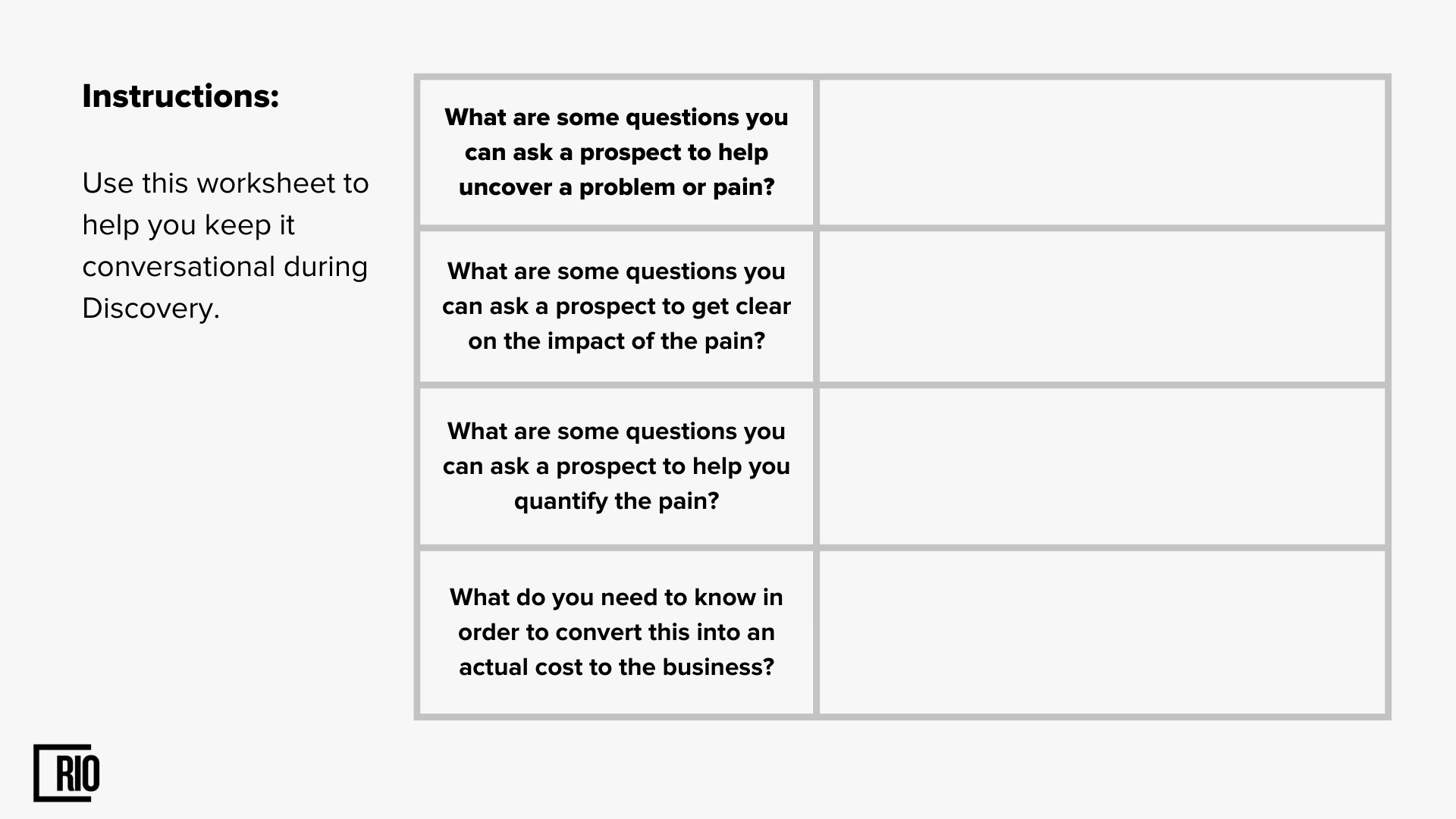
Write down the discovery questions beforehand
It doesn’t matter if you are a brand new sales rep or you have a lot of experience, it’s a good idea to have your discovery questions written out and in front of you.
And you may say that you don't need that because you are experienced. But I've seen some of the most experienced salespeople lose a sale, or forget a couple of important questions. And sometimes the newer salespeople do a better job because they are so structured, though, so methodical, as well as intentional about what they're asking.
No matter how long you have been selling, it is a good idea to have some questions written down that you can use to learn more about your customers. This will help you to better understand them and their needs. But be sure to practice asking these questions so it doesn’t look like you are reading from a list.

Even if you are a seasoned rep, you are still human, and we, humans, tend to forget even the easiest things. So, feel free to prove your experience and professionalism by actually taking notes and being absolutely ready for your call.
Don't be a machine gun questioner
Sometimes reps are overenthusiastic and go into "machine gun questioning” mode. And you may already know why this isn't the best thing to do for your prospect.
So, "machine gun questioning” that's when a rep will literally rattle off four or five questions at once. People usually expect the prospect to answer their questions in a logical order. But that never happens. The prospect usually just answers the first or last question and not the rest. Or don't answer anything at all because they just got annoyed with the salesperson.
If you are someone who asks a lot of questions, make sure you practice. Take the time to review some of your calls and listen to them. See if this is something you have been doing in the past. Instead, make sure you have a very systematic way of asking questions when you speak with people.

Stay Present
As sales professionals, we have to do a lot of things and the best salespeople make it look easy. But we all know it's not. It's important to maintain this curiosity that you have and stay present.
Sales professionals need to be prepared for anything when they are conducting discovery or a demo. It is easy to get sidetracked, but you need to stay focused on the customer. No matter what happens, it is important to be responsive and continue the conversation.
Reps sometimes ask questions in order to learn more, but they don't listen to the answer. And this is a mistake because the rep can learn a lot from what the prospect has to say. So always remember this: good questions are important, but so is understanding the answer.
Sometimes you get the best information from your prospects when you ask them follow-up questions. This can be either during an open-ended conversation or a closed-ended conversation. But you won't be able to ask those follow-up questions if we're not listening carefully.
Try to have this mindset: imagine you piece together a literal puzzle. And every answer is like a missing piece that goes into place. Of course, you can be distracted by pretty much anything, but it's your job to stay focused and present to piece this puzzle together.
I know, sales reps always have pressure on them and they're extremely aware of it, but try to ignore this looming cloud of expectations and just imagine that you're doing puzzles with your family.
Remember, people usually have some good information to share when you talk to them. The best thing to do is listen carefully and ask follow-up questions. That's where you can get the most useful information. Next time you're talking to someone, remember this advice.

Be naturally curious
It is important to be curious when you are talking to a potential customer. The best salespeople are truly curious and it really resonates with the prospect, they can really sense it when you are interested in what they are saying.
You should try to get into the moment when you are with your prospect. This means that you should not be thinking about other things while you are talking to them. It is also a good idea to have an idea of what their needs might be before the call. This is based on their job title, the size of their company, and what industry they work in. But don't forget that you might not know all the answers.
When you are in the discovery process, let's ask the right questions to understand their situation. This includes understanding their situation at an organizational level and an individual level.

Understand individual drivers
When you are doing your discovery, it’s crucial to explore the organizational needs and pain points. However, you also need to understand the individual's needs.
And here it's really important to understand what is happening organizationally but you also want to figure out what is driving this decision on an individual level, for the people who might be interested in your product.
For example, when you talk to your champion, why are they doing what they're doing? Is it because they want to make an impact on their career in the organization? Did their boss tell them to do it? Or are they trying to meet a deadline? There's often a reason why your prospect is doing what they're doing, and it's not just because of their organization. You need to drill down and understand that.
And thankfully there are some questions, that will help you to understand your prospect better:
- “I'd like to know why you have chosen this particular approach.”
- “When you're considering this option, you're thinking about rolling it out. It appears like organizationally, this is a major problem, but what are your personal views on it? What are your feelings and thoughts on where your company should go with this in the future?”
Some people might buy your product because it helps them reach their goals. For example, if you are a salesperson and need to hit certain targets, your product might help you do that.
Sales reps don't ask their customers enough how they are doing. For example, if you are selling a solution that helps sales organizations be better, the sales reps should ask how the organization is doing so far this year, this quarter, and this month.
Many people choose to ask their sales leader about their numbers. It is rare to see a sales professional take the opportunity to do the same.
When you get to the closing stage of a discussion and you're asking:
“Okay, fantastic, are you learning anything? Would you want to continue forward?”
If the prospect responds in the negative “Yes, actually no. I believe we're fine”, then you need to be ready to brace for this impact. You need to overcome this situation and let me tell you how you can do that.
To find the nuggets, you need to be effective when you are discovering things. You can do this by comparing and contrasting two different sales representatives. Sales representative A did not ask many questions, but Sales representative B asked a lot of questions and understood the pain that the customer was feeling. They also understood how the customer was tracking their progress.
If you get the same response from a prospect at the end of your call or sales process, it might be tough to convince them to switch to your product or service. If sales rep A says "So what do you think?" and the prospect says " I think we're gonna stick with our current solution," then sales rep A doesn't have much they can go on. It would be like saying "Oh, well, it sounded like you were pretty interested in this." This isn't a very compelling reason for the prospect to change their mind.
When sales rep B says, "Oh, so you want to understand what I'm thinking?" and the prospect says no, they can say things like, "I think we're going to stick with our current solution."Someone might say, "I would really like to understand that better. You said earlier that your team wasn't hitting their number last quarter, but next quarter you have a higher target. And you're not on track to meet your annual goal. But you don't have a current solution to help you meet your goal. Why do you think this isn't a good option?"

When you are at the end of a call and the prospect says they don't want to move forward, sales rep B has more information to work with. That's because sales rep B did a better job of discovery during the call. Make sure you are like sales rep B, not A.

Understand their decision-making process
It is important to understand the decision-making process before you ask any questions. You need to think about whether you should ask these questions during discovery or at the end of the call. But no matter when you ask them, there are some questions that I think are really important for you to understand.
I find that sales reps go too close to the bottom of the funnel and ask questions like "When do you want to make a decision?" This is six questions down the funnel, so it's not very high up. To highlight what I mean by "down the funnel," I'm going to show you again with a quick picture.
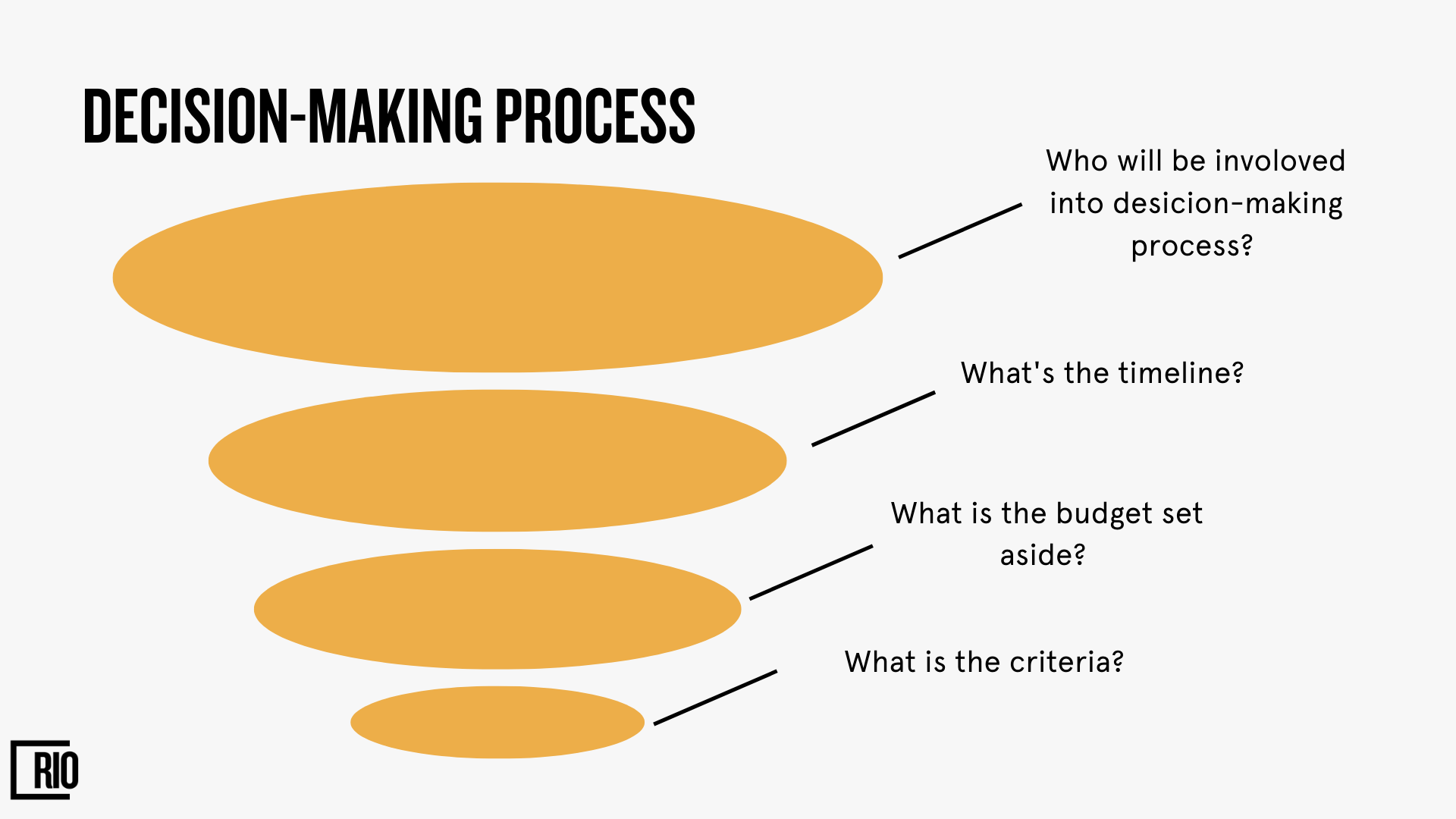
Down the funnel means thinking about someone's process of making a decision. You want to know what that process is, and then ask questions based on how they answer the first one. They might say that they have a committee. That's great! Can you tell us more about who is on that committee?
Then you want to ask them what their timeline is for making a decision. Do they have a budget set aside? And where are they in the decision-making process? Did they come in late? Did they come in early? What are the criteria?

What are the decision criteria that have been set for this situation? What is important to them when making a decision? Once we know what is important, we can ask them to rank each criterion in order of importance. For example, if there are three things that are important, the first might be the most important. We wouldn't know this without asking them directly.
If you know what your competition is doing, you can sell more effectively, close more effectively, and tailor your presentation to their needs.

Ask if they’re meeting with other providers
You want to know if they are meeting with other providers. This is important so you can understand their decision-making process. The best sales reps are constantly asking these questions. For example, you might say where you are in the decision-making process and they might say, "We're looking at four companies right now, including you."
If someone tells you that they are considering other companies, it is okay to ask them what they think of those companies. You can also ask them how your company compares. This will help you understand where you stand in comparison to the other companies that they are considering.

Always play the anchor position
Being the last person they talk to before they make a decision is always a good thing.
Let's say you're talking to a potential buyer and you're in the final stages of a deal. You know that there are other vendors being considered, and it turns out that there are four of them. Two people have already demoed their product. Today is your turn. And then the fourth person will demo their product tomorrow before the committee meets at, let's say, the end of the week.
Here I advise making sure that you are always the last vendor that the prospect has spoken to before they go into that meeting or final discussion.
There are several reasons why you should always go last in a presentation. One reason is people will remember you more if they hear from you last. But there's also another reason - so you can understand the other objections or de-positioning that the competitor might do. This way, you can prepare for it and have a response ready.
So how do we do this?
“We'd recommend that you have a brief conversation just before your committee meeting to save time. What our customers found to be really beneficial when they were in your shoes is to have a quick phone call just before the meeting begins, between each presentation, and then for any last questions regarding what you've seen, and if it's alright with you, can we put up a placeholder for Thursday at two o'clock?”
Some people will say no, but more often than not, they will say yes. Actually around 60% of the time, the prospect says yes.
Yeah, you may feel a little uncomfortable doing it, but remember that it's not just for you; it's actually in the best interest of the prospect as well.

Step outside your comfort zone
It can be a little scary to do discovery the first time. This is because you might ask questions that push the prospect further than you are comfortable with. However, it's important to remember that you might not be pushing the prospect at all. Make sure that you are willing to take risks if you want to grow.
If you feel comfortable attending today's meeting, you'll want to try to attend as many of the best meetings as possible. This will help give you more confidence and allow you to take your discovery process to the next level.
Sometimes it can be tough to ask people questions that might be sensitive. For example, if you want to know how they did last quarter in terms of sales. You can make it a little easier for them by giving them a heads up or leading into the question.
One way to prepare for asking sensitive questions is by giving some background information. For example:
“In these types of discussions, we often find it helpful to get a better understanding of your KPIs, specifically sales numbers. Is it okay if we take a closer look at that?”
And here is the last piece of advice for you: when you ask someone a question, you want them to understand why you are doing it. So, you need to explain the value of the question and then ask for permission to ask it. This is different from just asking someone a question without any explanation. People can feel defensive as if they are interrogated.
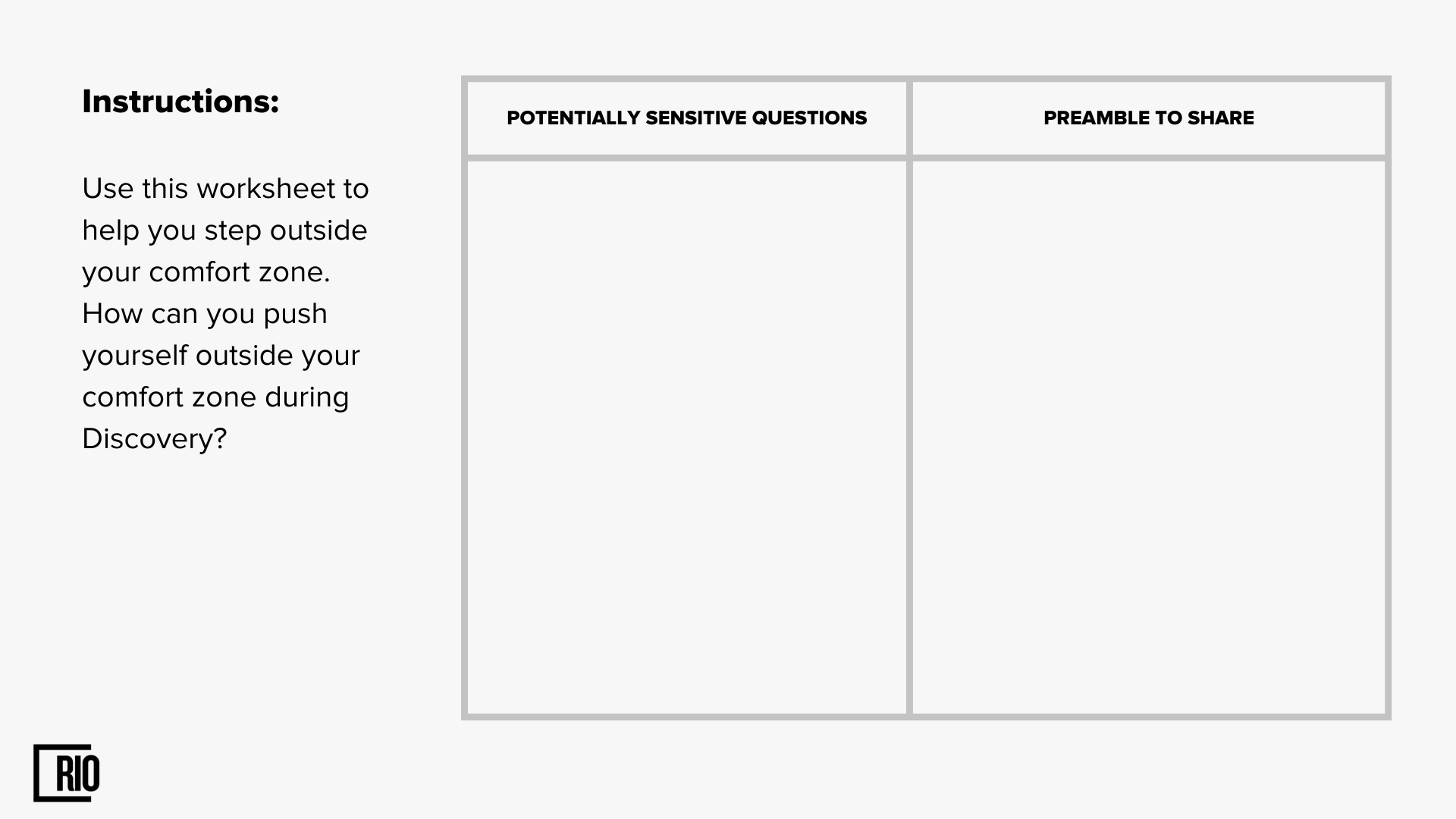
As I said before, the discovery process isn’t easy but you can make it easier. At the end of the day, it all comes down to being present, open-minded, and ready to understand and help.
Download worksheets
And, as promised, feel free to download these worksheets to practice new knowledge!


